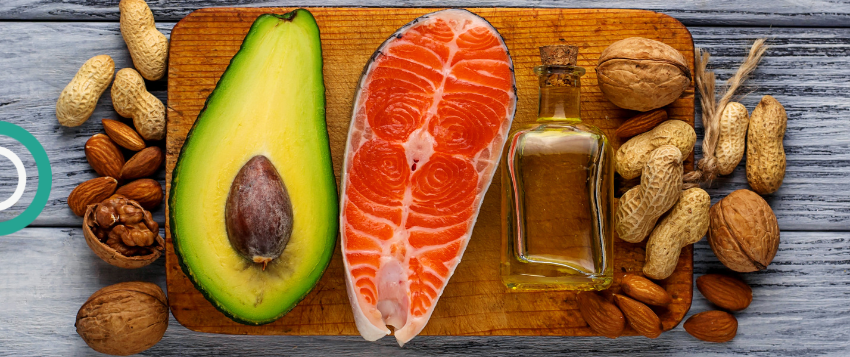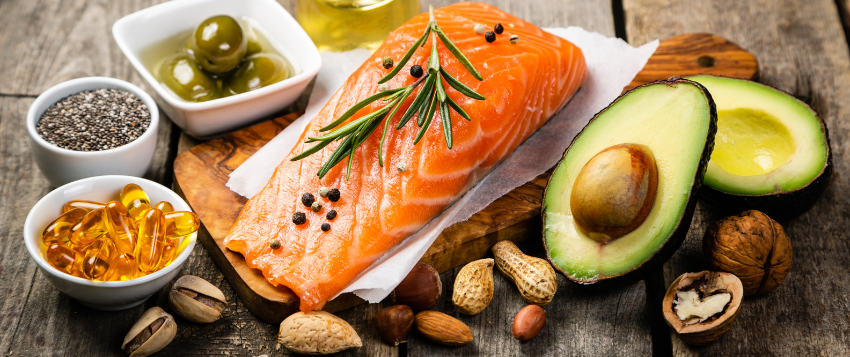As with carbohydrates, the fat food group should be approached with caution as overindulgence in the food included in this group could cause serious health risks. Too much fat, especially saturated fat, could raise your cholesterol levels and increase your risk of heart disease. But, let us discover the purpose of fat, the types and the intake suggestions, together.
As with all food groups, fats have specific and specialised functions in the body. But, before we discuss the functions of fats in the body, let us examine the different kinds of fats.
You might have heard that there are ‘good’ fats and ‘bad’ fats which is a basic breakdown of how the fats affect the cholesterol levels in the body. You might ask: cholesterol, what is that again? Cholesterol is a fatty substance essential for your bodily functions. A certain amount of it is healthy – it forms part of the cell walls and is necessary to make hormones. But there are two main types of cholesterol: low-density lipoprotein (LDL or bad cholesterol) and high-density lipoprotein (HDL or good cholesterol). Too much LDL cholesterol causes buildup in the blood vessels which makes them narrowed or blocked. The buildup of LDL could make it difficult to supply blood to the heart which can result in a heart attack or stroke.
So, within this explanation, we will therefore discuss healthy fats which the body needs to function well, and unhealthy fats which could cause health risks. The main types of fat found in food are saturated and unsaturated fats. Most foods contain saturated and unsaturated fats in different proportions.
Saturated fats
High concentration of saturated fat is found in meat and dairy products as well as in some plant foods (like coconut and palm oil). It is also in most savoury snacks and chocolate confectionery, biscuits, cakes and pastries. Eating too much of these fats could increase LDL levels in the body.
Unsaturated fats
Unsaturated fats are divided into monounsaturated and polyunsaturated fats. Monounsaturated fats are found in olive oil, avocados, and some nuts (almonds, Brazilians, and peanuts). Polyunsaturated fats are omegas-3 and -6. Some types of omegas-3 and -6 cannot be made by our body which means that we must ensure that we add them to our daily food intake. Omega-6 is found in vegetable oils (like sunflower and rapeseed oil) whilst omega-3 is found in oily fish.
Functions of Fat
We have briefly identified above that some fats are essential to include in your daily food intake as the body cannot produce these on its own. Fat is essentially the source of fatty acids which assist the body to absorb vitamins A, D and E. Furthermore, fats provide energy, offer insulation and protection, and play a role in regulating and signalling.
As with protein and carbohydrates, fat can be stored and provides a long-term energy reserve for the body when needed. The stored energy is used by your body to fuel muscles. Fat cells are specialised for fat storage, but a large number of fat cells could cause many diseases (as discussed throughout this range of articles) and is a deterrent to maintaining a healthy lifestyle.
The average human body needs a layer of fat for insulation and protection. The percentage of fat needed is individualised (according to energy consumption, age, and gender) but generally 18–24% for males and 25-31% for females. This amount of fat is stored throughout the body in the abdominal cavity (called visceral fat) and underneath the skin (called subcutaneous fat). Visceral fat protects your organs whilst subcutaneous fat assists the body with temperature control. It also protects the body (like extra padding).
Furthermore, fats help the body produce and regulate hormones. They also play a vital role in sustaining nerve impulses, memory storage and tissue structure and help to form nerve cell membranes and enable the signalling of electrical impulses through the brain.
Yet again, fat is an essential food group, and as you can see, the functions of fat in our body should not be cut out of our food intake per day. Knowing how much fat to include in our food intake is critical to good health.
How much is enough?
Becoming mindful of our fat intake is very important. As said at the start of this article, fat is present in different food sources. Broadly, it is recommended that 20-35% of our total calories are consumed through fat sources. This is about 44-77 grams of fat a day (if you eat 2,000 calories a day). Also, calculating the fat intake daily is a bit more complex as you need to calculate the fats included in the protein (for example) that you consume. Together, everything should translate to your daily intake percentage. This means that you must know what a portion of fat is: for example, 10 peanuts equal 5 grams of fat (which translates as one portion).
Becoming more aware of the fat percentage of different food sources is also very important. For example: choosing to eat one portion of full-cream milk against one portion of low-fat milk. One cup of milk (250ml) contains 7.9 grams of fat whilst the same amount of low-fat milk contains 2.4 grams.
Analysing the fat content of the food we consume is therefore critical together with assessing whether the fat contained in the food is saturated or unsaturated fat. Very often, it means that you do not need to add additional fats (like nuts) to your daily intake because the food that you already eat contains enough fat to support the recommended daily intake.
Thus, as argued in all the previous nutrition articles, cutting out an essential food group is not recommended. Getting educated about that food group, and your relationship with it is essential.
Choose carefully and be choosy – your body deserves it!
Disclaimer – Healthi and its associates offer health and fitness information and are designed for educational and entertainment purposes only. You should consult your physician or general practitioner before beginning a new fitness programme. You should not rely on this information as a substitute for, nor does it replace, professional medical advice, diagnosis, or treatment. If you have any questions or concerns about your health, you should always consult with a physician, general practitioner, or other qualified healthcare professional. Do not disregard, avoid or delay obtaining medical or health related advice from your healthcare professional because of something you may have read in our publications or lectures. The use of information provided through the Healthi service is solely at your own risk and is not medical or healthcare advice.









